| Columns Retired Columns & Blogs |
Focal Maestro Utopia III loudspeaker Measurements
Sidebar 3: Measurements
Measuring the behavior of a speaker as large and heavy as the Focal Maestro Utopia III is problematic. Ultimately, I had to perform the acoustic measurements with the speaker in my listening room. Even though I maneuvered one of the Maestros as far as I could from the sidewalls and fired it along one of the room's diagonals, in order to push back room reflections as far as possible in time after the arrival of the speaker's direct sound at the microphone, the results don't have as much resolution in the midrange as I would have liked, or as I routinely achieve with smaller speakers, with which I can optimize the test setup. As usual, I used DRA Labs' MLSSA system and a calibrated DPA 4006 microphone for the farfield responses, and an Earthworks QTC-40 for the nearfield and spatially averaged room responses.
I examined the Maestro Utopia's electrical impedance and phase with both an Audio Precision System One, which uses swept spot tones, and MLSSA, which uses an MLS signal and FFT analysis. I used two different systems and measured both speakers because the Focal's impedance was idiosyncratic in the upper-bass region, and I wanted to be sure that I was characterizing it correctly. Fig.1 shows the impedance and electrical phase with the speaker's three tone-control jumpers in their boost ("3") and cut ("1") positions. Position "3" gave the lowest impedance in the mid-high treble, and the highest impedance in the low-treble and bass regions, but the impedance wasn't significantly affected by the jumpers in the region of special interest, between 60 and 300Hz. The magnitude lies below 4 ohms in this region, with a plunge to just 1.7 ohms at 111Hz rather than the specified minimum of 3 ohms.
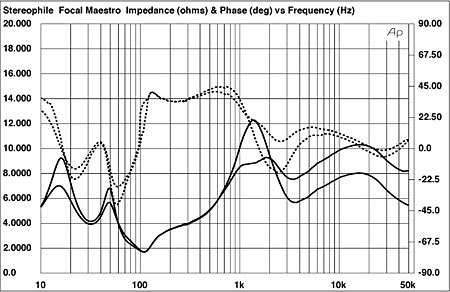
Fig.1 Focal Maestro Utopia III, electrical impedance (solid) and phase (dashed) with jumpers set to "3" (upper traces below 100Hz and between 1 and 2kHz; lower traces above 2kHz) and with jumpers set to "1" (2 ohms/vertical div.).
As taxing as this will be for an amplifier, there are combinations of 3.75 ohms and –37° phase angle and 2.3 ohms and +40° at 62Hz and 126Hz, respectively, which will also demand very high currents from the amplifier. As all music has considerable energy in this region, the Focal's owner will have to use an amplifier that can genuinely deliver high powers into 2 ohms if the speaker is to be allowed to sing as it should. Even then, as I found with the otherwise superb Simaudio W-7 amplifier, the high phase angle at infrasonic frequencies may well cause the amplifier to go into protection with a wideband pulse as it encounters what appears to be a short circuit on its output.
Higher in frequency in fig.1, the impedance remains above 5.7 ohms above 600Hz, with a modest phase angle. This makes the Maestro Utopia III a distinctly schizophrenic load for the partnering amplifier: very difficult for any amp to drive in the upper bass, but very amplifier-friendly in the upper midrange and treble. It is a good thing, therefore, that the Focal is very sensitive, playing very loud with only a few watts of power. My estimate of its voltage sensitivity on its tweeter axis was 92.6dB(B)/2.83V/m, which is within experimental error of the specified 93dB.
The traces in fig.1 are from slight discontinuities that would suggest the presence of cabinet resonances of some kind. Listening to the walls of the midrange and woofer enclosures with a stethoscope while I played the half-step–spaced toneburst track from Editor's Choice (CD, Stereophile STPH016-2), I heard no undue emphasis in the midrange, other than a slight liveliness from both the midrange and woofer enclosures at around 275Hz.
The rather complicated set of traces to the left of fig.2 shows the outputs of the three lower-frequency drive-units and the port, measured in the nearfield and scaled in the ratio of their radiating diameters. The midrange unit (green trace) crosses over to the upper woofer (blue) at around 150Hz, the latter rolling off with a relatively shallow slope. The lower woofer (purple) peaks a little lower in frequency than the upper, with a much steeper low-pass rollout. Peculiarly, though the large, downfiring port loads the lower woofer's subenclosure, it is the upper woofer that has a better-defined minimum-motion notch in its response, at 28Hz, which is a little lower in frequency than predicted by the speaker's impedance graph. The port's output (red) peaks in the midbass and rolls off rapidly above that region.
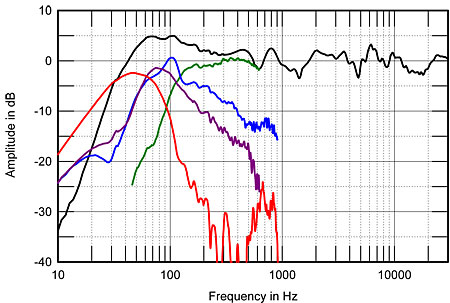
Fig.2 Focal Maestro Utopia III, anechoic response on tweeter axis at 50" with jumpers set to "3," averaged across 30° horizontal window and corrected for microphone response, with complex sum of nearfield responses plotted below 300Hz (black) and with nearfield responses of midrange unit (green), upper woofer (blue), lower woofer (purple), and port (red).
The black trace below 300Hz in fig.2 shows the complex sum of the individual nearfield outputs. The broad boost in the upper bass will be partly due to the nearfield measurement technique, which assumes that the radiators are housed on the face of an infinite plane; in true anechoic conditions the Maestro Utopia's low frequencies will extend down to the port tuning frequency, where it will be down by 6dB. Higher in frequency in fig.2, the Maestro's balance on the tweeter axis is basically flat, though with small peaks balanced by small dips and extending at full level out to the 30kHz limit of the graph. This measurement was taken with all the midrange and treble jumpers in the "3" position. Changing the treble jumper to "2" shelves down the speaker's output above 3kHz by 1dB; the "1" position drops that region by another dB. The midrange jumper also gives a 1–2dB reduction in level, but covering just the octave between 2 and 4kHz.
The Maestro Utopia is too heavy to be placed on my Outline speaker turntable, so I could practically measure its lateral dispersion only across the same ±15° window I used to generate the black trace in fig.2. I haven't shown the resultant graph, but the Maestro's balance doesn't change to a significant extent across that horizontal angle, this correlating with the superbly stable stereo imaging. The speaker was similarly uncritical in the vertical plane (fig.3), which is just as well, given that its tweeter is 45" from the floor.
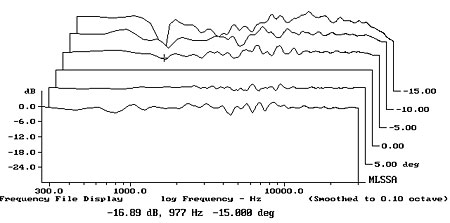
Fig.3 Focal Maestro Utopia III, vertical response family at 50", normalized to response on tweeter axis, from back to front: differences in response 15–5° above axis, reference response, differences in response 5–10° below axis.
The red trace in fig.4 shows the Maestro Utopia's spatially averaged response in my listening room. I produce this curve by averaging twenty 1/6-octave–smoothed responses taken for each speaker individually in a vertical rectangular grid measuring 36" by 18" and centered on the positions of my ears in my listening chair. I used an Earthworks omni microphone and a Metric Halo ULN-2 FireWire audio interface, in conjunction with SMUGSoftware's Fuzzmeasure 2.0 running on my Apple laptop. Other than some lumpiness in the lower midrange due to residual room effects, the Focal's in-room balance is very smooth. There is a slight excess of energy evident in the mid-treble, though the upper octave is suppressed by the increased absorptivity of the room's furnishings in this region. Reflecting the implications of the overall nearfield response in fig.2, the upper bass is a little exaggerated in level before shelving down below the room resonant mode in the 50Hz region. The speaker is still putting out useful energy below 30Hz, however.
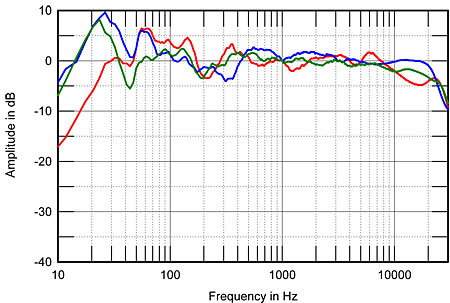
Fig.4 Focal Maestro Utopia III, spatially averaged, 1/6-octave response in JA's listening room (red); of Aerial Acoustics 20T V2 (blue); and of Revel Ultima Salon2 (green).
For reference, the blue trace in fig.4 shows the in-room response, taken under identical circumstances, of the Aerial 20T V2, which I reviewed in November 2009. The wide, top-octave lateral dispersion of the American speaker's ribbon tweeter results in more top-octave energy. There is a little less upper-bass energy apparent, though the Aerial's port pumps out more energy below 40Hz than that of the more overdamped Focal. The green trace shows the spatially averaged response of the Revel Ultima Salon2. This speaker is as smooth as the Aerial, but with a little less upper-midrange energy evident. The Revel's top octave falls between the Aerial's and the Focal's and is, I believe, about right, given the French speaker's mellower balance and the Aerial's always-exciting highs. In the bass, the Revel's three woofers are more successful than the two woofers of each of the other speakers at producing an even upper-bass balance, but the low-bass room mode is excited almost as much as it is with the Aerial.
In the time domain, the Maestro Utopia's step response on the tweeter axis (fig.5) indicates that the tweeter and midrange unit are connected in inverted acoustic polarity, with the decay of the tweeter step smoothly blending into the midrange unit's step. Similarly, the decay of the midrange step smoothly merges into the start of the woofers' positive-going step, which suggests optimal crossover design. The cumulative spectral-decay plot on the tweeter axis (fig.6) is affected by the presence of early reflections, hence doesn't look as clean as I expected—or, for that matter, heard. That small peak in the mid-treble is associated with some delayed energy, though the region covered by the tweeter is clean.
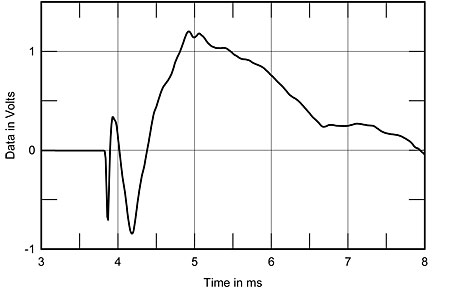
Fig.5 Focal Maestro Utopia III, step response on tweeter axis at 50" (5ms time window, 30kHz bandwidth).
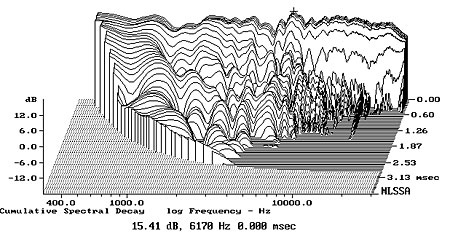
Fig.6 Focal Maestro Utopia III, cumulative spectral-decay plot on tweeter axis at 50" (0.15ms risetime).
Measuring a loudspeaker as large and heavy as the Maestro is never as straightforward as one might wish, due to the difficulty of getting the speaker well away from room boundaries, especially the floor. But within the inevitable limitations of the measurement procedure, the Focal Maestro Utopia III's performance suggests superb speaker engineering.—John Atkinson
- Log in or register to post comments




































